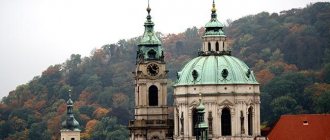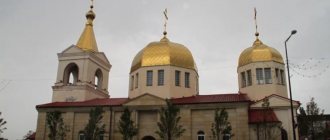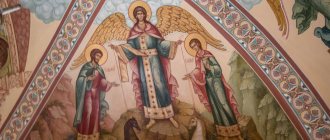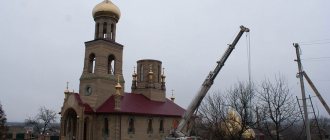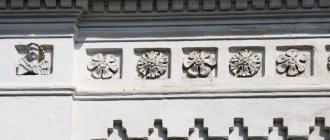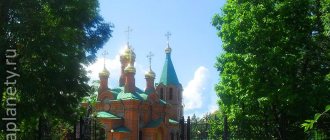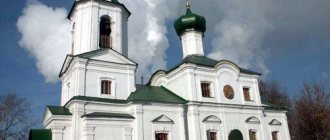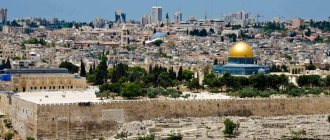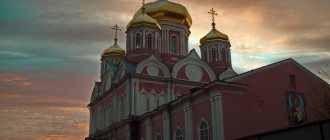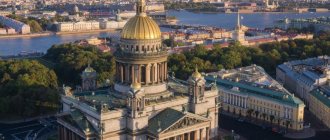What is an Orthodox church?
The temple is called the House of God. Orthodox Christians believe that the Creator and Maker himself is invisibly present in the church. In Greek, the Orthodox church is called “kyriaki, kyriakon” - “the dwelling of the Lord.” At the same time, there is a significant difference between the Christian understanding of the temple and the pagan one. The pagans believed that their gods directly lived in the temples, they were “attached” to them. In Orthodoxy, a temple is a shrine and a place of special closeness to God.
Orthodox church
“The world is a foreign country to us, our home is in heaven, the threshold of this house is an earthly temple. Hurry here, as one rushes from a foreign country to the roof of one’s parents. Just as children rush to the call of their beloved mother, wanting to enjoy her caresses, so you rush to the temple. Here our mother, the Church, will lovingly embrace you and abundantly nourish you with all sorts of spiritual sweets” (St. Theophan the Recluse, 1815-1894).
Orthodox Church: history of formation
The first Eucharist was celebrated by Jesus Christ in the upper room of an ordinary home. In imitation of this, the first Christians also celebrated the Eucharist in residential buildings, in rooms specially designated for this purpose. These were the first house churches. During the persecution of Christians, services were held in catacombs (underground galleries). From the 4th century, when persecution ceased, church art began to develop, including temple architecture.
The very appearance of the Orthodox Church indicates that this is not an ordinary house. The orientation of the temple to the east is associated with the image of the Savior. Jesus Christ is the “Sun of Truth” (Malachi 4:2), and the sun rises in the east. In addition, in the east, as the Bible tells us, there was the Garden of Eden (Genesis 2:8).
There are three main architectural types of Orthodox churches: basilica, cross-domed and tent-roofed.
Basilicas are rectangular buildings with a flat ceiling and a gable roof. This is historically the earliest form of temples. Christians adapted Roman civil basilicas for ritual purposes, which do not have strong associations with paganism. They conducted trials and resolved financial issues.
The modern Western European basilica has a cross shape.
The appearance of cross-domed churches dates back to the 5th century. In such churches, the general plan clearly shows 2 intersecting axes forming a cross.
The appearance of the tent type dates back to the end of the 15th century. Instead of domes, a pointed tent with a dome was installed above the church.
Construction of an Orthodox church
A church may have several chapels, that is, additional altars. Side chapels are installed in churches designed to accommodate many people or to hold several services a day. The temple building is completed by a drum with a dome. The Old Russian folk name for domes is “makovitsa” (the dome was shaped like a poppy head). Often church domes are called domes (“heads”), and drums are compared to necks. The symbolism of the dome is filled with dogmatic meaning. This is an image of the firmament, as well as the connection between heaven and earth. The presence of one dome indicates that the Church has only one Head - Jesus Christ.
The presence of two domes indicates the two natures of Jesus: God and man. The three domes are a symbol of the Holy Trinity. The four domes symbolize the Four Gospels. Five - Christ and the four evangelist apostles. The seven domes indicate the seven sacraments of the church. The nine domes symbolize the nine ranks of the heavenly angelic army. Ten is Jesus Christ himself with the heavenly army (9 ranks). Thirteen - the Savior with the twelve apostles.
On every dome of an Orthodox church there is always a cross. This symbolically indicates Christ's victory over death.
Architecture in the Orthodox Church is a rather complex system
First, let's look at the appearance of the temple and its parts.
An apse is a semicircular or polygonal projection in a temple where the altar is located. We have already talked about what an altar is and where it is located.
An arcature belt is a series of decorative wall decorations in the form of small arches.
Drum - the upper part of the temple, having a cylindrical or multifaceted shape, on which the dome is erected
There are two types of drum:
- light - cut windows, usually rectangular or arch-shaped;
- deaf (blind) - relatively narrow, without slits. Often such a drum under a dome is called a neck. You can clearly see this in the photo.
The head of architecture is the dome crowning the temple building.
Zakomars are semicircular completions of the upper outer walls of the church made in the form of a vault. Appeared back in the 12th century. More modern roof coverings appeared at the end of the 20th century and became more resistant to rain and snow.
Cube is a concept that defines the internal volume of a temple.
The nave is the inner part of the temple, located between the arcades.
The porch is a place made in the form of an open or closed ring in front of the entrance to the temple.
Sails are elements of a dome structure in the shape of a spherical triangle, providing a transition from the square under the dome space to the circumference of the drum.
A pilaster is a vertical protrusion on the surface of a wall, flat in shape, that performs constructive or decorative functions. Basement - part of the building corresponding to the lower floors.
Chapel - an extension to the main church building, which has its own altar in the altar and is dedicated to one of the saints or church holidays
The refectory is an extension on the western side of the church. It was a place for sermons and public meetings. They were sent here as punishment for sins, to atone for them.
A tent is a pyramid-shaped polyhedron structure that served as a covering for churches and bell towers.
The apple is an element on the dome, made in the form of a ball under the base of the cross.
Tier - division of the volume of a building in the horizontal plane, decreasing in height.
Orthodox churches use curved ceilings. These are the vaults of the temple
What are the vaults of the temple? Temple vaults are a type of ceiling or covering of a room, limited by walls, beams or pillars. In a different way, it is a structure that is formed by inclined surfaces. For example, curvilinear, rectilinear.
Temple parts
The structure of the church has its own characteristics. An Orthodox church consists of three parts: the narthex, the temple itself and the altar. The presence of an altar is a prerequisite. The prototype was the decoration of the Jerusalem Temple of Old Testament times.
In early Christian times, the porch was a place for catechumens (those preparing to be baptized). Previously, the sacrament of Baptism was performed several times a year, so the vestibule was built of considerable size. When the baptism of people became regular and in infancy, the need for spacious vestibules disappeared. Now in some churches there are no vestibules completely. And if they exist, then mainly as a thermal insulation room. A candle box can be placed in the vestibule. Sometimes a kanun is placed there (a table for candles for the repose),
According to church regulations, litias at vespers should be celebrated in the narthex. However, in modern practice this is rarely the case. The size of the vestibule does not allow the clergy and parishioners to be accommodated.
Wooden Rus'. Izba - a macrocosm of Russian scale
The architecture of Ancient Rus' is a unique phenomenon in the history of architecture. Despite the power of the stone forms and the often fortress-like nature of the white stone monoliths, it cannot but amaze with its beauty. Perhaps, now these are the only buildings that make you feel the aroma of long-gone centuries with epic heroes and barbarian tribes of the Mongol-Tatars. But the path to white stone architecture was very difficult and long. And it began with a wooden hut.
Not every resident of a modern metropolis has been to a real Russian hut. Most of the old villages are irrevocably a thing of the past, while some, on the contrary, are being built up with mansions, sometimes in neo-Russian style: many do not want to part with the spirit of antiquity.
If we talk about the design of a real Russian hut, then it is a wooden log house (or two log houses), covered with a gable roof, or less often with a hipped roof. Four logs, folded into a rectangle, were connected at the corners of the house using notches, forming a crown. There were two types of cuttings: “in the oblo” (“in the bowl”), which is found in very old buildings and village huts, and “in the paw” - more complex than the first, but more economical. The crowns were superimposed on each other, and a log house was obtained. To build large buildings, several log houses were connected.
Log houses were often decorated, especially in the north, with carvings. Window frames, shutters, gates—their lace wooden ornaments included fancy figures of fantastic creatures. The hut became very elegant!
Cutting corners “into the edge” also has another name – “into the bowl”. “Obly” in ancient times meant “round.” This connection of logs is considered the most ancient. The basis of the cut was a round bowl carved into a log. This recess was directed upward. A transverse log was placed into it. The option of cutting corners, when the logs are cut straight from the ends (without any residue), is called “in the paw”.
Most of the wooden houses with which ancient Russian cities were built were not much different from a peasant hut. Some houses were built two-story, many were placed on a basement - a semi-basement floor that served for household purposes. In a simple one-story wooden house, in addition to the main room - the upper room - there was also an additional room - living room. And adjacent to the log house was a vestibule—the entrance part of the house. It’s interesting that now we almost never use the word “canopy”. But in everyday life the French version is the lobby!
A large stove was placed in the center of the hut, which heated the entire building and was called Russian. Everything depended on her - both warmth and human well-being.
Middle part of the temple
Having passed the porch, a person finds himself in the temple itself. It is here that the unity of all members of the Church, heavenly and earthly, takes place.
In the center of the temple there is a lectern with a festive icon. Also, lecterns can stand in the place of confession. As a rule, a kanun (place of remembrance of the dead) is placed on the north side. In any temple there is an image of Golgotha in the form of a large wooden cross with the image of the Savior. The cross is mounted on a stand in the shape of a stone hill. On the front side of the “slide” there is a skull and bones - the remains of Adam. On the right side of Christ is the Mother of God. On the left hand is an image of the Apostle John the Theologian. This image serves as a reminder that all believers, like John the Theologian (Gospel of John, 19:26-27), are children not only of the Lord, but also of the Mother of God.
Icons in the temple are placed on the walls, columns, in icon cases (glazed cabinets) near the walls and iconostasis, and also in the altar.
The inside of the temple is illuminated not only by natural light through the windows, but also by metal lamps. This is a large chandelier, suspended in the center of the temple on the dome or ceiling, and the chapel chandeliers. Currently, wax candles on chandeliers in almost all churches have been replaced by electric light bulbs for practical reasons. They are lit in accordance with the liturgical Charter. So, for example, the lights at the evening service are extinguished during the reading of the Six Psalms, when the penitential psalms are read. While singing the Mother of God song “My soul magnifies the Lord,” candles and lamps are lit as a sign of special veneration of the Most Holy Theotokos.
The place for the choir and readers in the temple is called the choir. It can be located either to the right or to the left of the iconostasis. Sometimes there are two of them to accommodate two choirs.
Temple, cathedral, church, chapel - what's the difference?
Pronichev Sergey.1 year agoReply
A cathedral is the main temple of a city or monastery. - this is the opinion of illiterate representatives of the Russian Orthodox Church MP. You can also see the opinion that this is the largest temple in the city or monastery. This is due to the fact that during the time of impostors from the House of Romanov on the throne (https://www.youtube.com/watch?v=DCL4TpEo12E), councils were canceled, and the practice of holding them in the Russian Orthodox Church arose only in post-Soviet times. But it is necessary to explain the term Cathedral as the name of a temple, but the knowledge is lost. Cathedral (Old Russian collection, cathedral from the Old Church Slavic collection) - collection, gathering. A cathedral is “the main temple of a city or monastery, as well as the main temple of a department, where a high clergyman can perform divine services - a patriarch, metropolitan, archbishop, bishop, protopresbyter of the military, naval or court clergy.” In large cities, each of the administrative parts of the city had its own cathedral built. The Hundred Head Cathedral is a church and zemstvo council, which was held in Moscow from February 23 to May 11, 1551 (7051) in the Assumption Cathedral of the Kremlin, with the participation of Tsar Ivan the Terrible, the highest clergy and representatives of the Boyar Duma. In total, from 1549 to 1684, such councils were convened from 45 to 60 times. However, their exact number cannot be established due to the small number of sources and written monuments of the initial period. They discussed mainly issues of foreign and domestic policy, tax collection rules and other legislative acts. Abroad. The Cathedral of Notre-Dame de Paris, also the Parisian Notre-Dame Cathedral or Notre-Dame de Paris[1] (French Notre-Dame de Paris) is a Catholic church in the center of Paris, one of the symbols of the French capital. Cathedral of the Archdiocese of Paris. Located in the eastern part of the Ile de la Cité, in the 4th arrondissement, on the site of the first Christian church in Paris - the Basilica of St. Stephen, built, in turn, on the foundation of the Gallo-Roman Temple of Jupiter. The Gothic cathedral was built on the initiative of the Parisian bishop Maurice de Sully in the period 1163-1345. 1302 - Philip IV opens the first parliament of the Kingdom of France - the States General. Cathedral. From the first century of Christianity we have a classic testimony about this from the apostolic disciple, the Roman bishop Clement in his letter to the Corinthians, which, by the way, clearly speaks of episcopal succession from the Apostles. The beautiful and solemn way of electing a bishop is depicted in the Apostolic Constitutions as follows: “Let the people assembled on the Lord's day with the council of elders and in the presence of bishops give their consent. Then let the eldest among the other bishops ask the elders and the people, is this the one they want to have as their leader (bishop - author's note)? And when they answer in the affirmative, let him again ask whether everyone testifies that he is worthy of this great and noble leadership and whether he truly fulfilled what relates to his duties in relation to God, whether he violated the rights of people, whether he organized the affairs of the house well ( We are talking about a married candidate - author's note) and is he impeccable in life? And when everyone has testified according to the truth, and not from prejudice, as before the judge God and Christ and before the Holy Spirit and all the saints and ministering spirits, that he is such, then again for the third time let them be asked whether he is really worthy of the priesthood, that by the mouth of two or three witnesses every word might be established; when he confirms for the third time that he is worthy, then let them demand a sign of consent from everyone (we are talking about voting by show of hands - author's note). And when the latter is voluntarily fulfilled, let them remain silent. Then, when silence comes, one of the first bishops with two others, standing near the altar while the rest of the bishops and presbyters are secretly praying, and the deacons are holding the divine Gospels open over the head of the one being ordained, let him say a prayer,” etc. Cyprian, Bishop of Carthage of the 3rd century, says this in one of his epistles, for example: “it is necessary to carefully preserve and observe the divine tradition and the Apostolic institution, which is preserved among us in almost all regions and according to which, for the legal installation of a bishop to a known people, it is necessary , so that the closest bishops of that region gather, and then let a bishop be elected in the presence of the people, who know well the life of each individual and usually observe the actions of each.” Thus, both these and other evidence show in the most obvious way that the Council of Nicea by this (4) rule only expressed in full form what was practiced in choosing a bishop before it and in its time. These prescriptions of the Council of Nicea are confirmed by many historical examples of later times. Therefore, buildings were specially built for holding meetings and cathedrals. family temple p. -a. Borrowing from Tslav., St.-Slav. temple, with the original Russian mansion (see mansion) [Mahek continues to defend his rapprochement of glory. words from the Hittites. karimmi "temple"; see "Sprashe", 4, 1958, p. 74. - T.] Cult terms, if faith came from Byzantium, should have a Greek nature, and not Latin... but our church dictionary is simply overflowing with Latinisms. The Russian word church is consonant with the Latin cyrica (circle of believers), and not the Greek eklesia, where the French “eglise” comes from. The Greek name jumped to Latin France, and the Latin name moved from Rome to Russia. The word "church" is not a translation of any word used either by Christ or His Apostles, but the Anglican form of another word with which the Roman Catholics replaced the word used by Christ and His Apostles. The English Bible is by decree of King James, who ordered his translators in 1611 not to translate the word "ecclesia" as "community" or "assembly", but to use the word "church" instead. The origin of the word “church” is neither Hebrew nor Greek. In fact, when the Bible was translated, the word church already existed. The Greek word used in the New Testament for “church” is “ekklesia,” which means “the called out ones.” The word "Ecclesia" does not refer to a building, but... to a group of people, and the correct translation of the word "ecclesia" should be "community, assembly or group." Strangely, in Acts 19:32, the word “ecclesia” is translated “assembly,” but in other passages the same word is translated “church.” The usual translation of the word "church" is "a building for public worship, especially Christian worship: the society of all Christians as a spiritual body." The word faith itself comes from the Latin word vera, that is, “Truth,” whence the French verite, and not from the Greek doxa.
Orthodox church: altar part
The eastern space of the temple is occupied by the altar. It is elevated above the rest of the temple (“altar” from Latin - “high”). Symbolically, this is the place where God resides.
The iconostasis separates the altar from the temple. This wooden structure has special recesses in which images of saints are placed. These icons are arranged in rows (tiers) and are called ranks.
The iconostasis is symbolically the boundary between the visible and invisible worlds. The iconostasis also serves as a prayer image, in fact, the largest icon in the temple.
Initially, the altar was not visually separated from the believers. Columns and low bars served as the border. Only from the 5th to 7th centuries did they begin to place icons on them.
The raised area in front of the altar is called the solea. Opposite the Royal Doors, its semicircular protrusion is called the pulpit (in Greek - “elevation”). From the pulpit, the priest delivers sermons or addresses worshipers in the church. Also on the ambo the Gospel is read during the Liturgy, litanies (special petitions) are proclaimed. Standing on the pulpit, the priest administers communion to parishioners who approach him.
Novgorodskopsk architecture. From St. Sophia Cathedral to Toadstool Chambers
The distinctive features of Novgorod architecture were monumentality, simplicity and the absence of excessive decorativeness. The origin of the Novgorod school dates back to the middle of the 11th century, the time of construction of the St. Sophia Cathedral in Novgorod. By order of Prince Yaroslav the Wise, construction began on the walls of the Detinets (Kremlin), a fortified part of the ancient Russian city. And some time later, a grandiose stone temple dedicated to Sophia (the Wise) was founded in Detinets.
The temples of Novgorod do not amaze with their huge size. They are simple and heavy. When you look at them, you get the feeling that they seem to have grown into the ground so firmly and monolithically that they are able to withstand any siege.
Temples were decorated with fresco paintings. The Church of Fyodor Stratilates on the Stream is famous for its frescoes by Theophanes the Greek. You can still admire them now.
Pskov architecture is very close to Novgorod. A lot of churches were built here, which received interesting names: St. Nicholas on Usokha, Vasily on Gorka, Assumption on Paromenye with a belfry. In Rus' they loved “talking” names.
Few buildings of secular architecture of the Novgorod and Pskov lands are known, among them the most monumental are the Pogankin Chambers in Pskov, built in 1671–1679 by the Pogankin merchants. The building resembles a kind of palace-fortress, because its walls, two meters thick, are made of stones.
Altar
The main part of the temple is the altar. In this sacred place the Bloodless Sacrifice is offered and the Body and Blood of Christ reside. The symbolism of the altar was influenced by John the Theologian's vision of the heavenly temple (Book of Revelation, chapter 4).
The central place in the altar is occupied by a throne (a quadrangular table). Only clergy can touch it. A temple without a throne is a simple building. The throne is covered with white linen (symbolizing the Shroud), and on top - with brocade (the royal clothing of Jesus Christ sitting on the heavenly throne).
Sacred objects are placed on the throne. This is an antimension (in Greek “in place of the throne”), which is a sign of the blessing received from the bishop for the performance of divine services. Pieces from the relics of saints are sewn into the antimension as a memory of the fact that the Liturgy was previously celebrated over the tombs of martyrs. A sponge is placed on the antimension to collect particles of the Holy Gifts (a symbol of the sponge with vinegar that was brought to the lips of Christ during the crucifixion). The Gospel on the throne symbolically recalls the presence of the Lord himself. A cross with a crucifix is a weapon for saving people.
A tabernacle in the form of a metal vessel in the shape of a church is placed on the altar. Specially prepared Holy Gifts (spare) are stored here for the communion of the sick. Also on the throne is a monstrance, intended for carrying the Holy Gifts when it is necessary to give communion to the sick outside the church.
